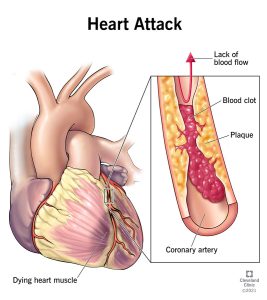A heart attack is a serious medical emergency caused by a sudden blockage of blood flow to the heart. It is one of the leading causes of death in the UK, but quick recognition and treatment can save lives.
While heart attacks are often confused with sudden cardiac arrest, they are very different conditions. Understanding what a heart attack is and how to respond could make all the difference in an emergency.
What Causes a Heart Attack?
A heart attack, also known as a myocardial infarction, happens when blood flow to part of the heart muscle becomes blocked. The heart muscle is starved of oxygen, which causes damage or death to the affected tissue.
The blockage is usually caused by a build-up of fatty deposits called plaque in the coronary arteries. If a plaque ruptures, it can form a clot that completely blocks the artery. This stops oxygen-rich blood from reaching part of the heart.
Without oxygen, heart muscle begins to die. The longer the delay in treatment, the greater the damage.
What Are the Symptoms of a Heart Attack?
The symptoms of a heart attack can vary, but the most common signs include:
-
Chest pain, tightness or pressure that may spread to
-
the arms, neck, jaw, back or stomach
-
Shortness of breath
-
Feeling light-headed or dizzy
-
Sweating
-
Nausea or vomiting
-
An overwhelming sense of anxiety o
-
r impending doom
Symptoms may come on suddenly or build up gradually. Some people, especially women, may experience less typical signs such as indigestion, fatigue or back pain.
If you suspect someone is having a heart attack, call 999 immediately. Do not wait to see if symptoms go away.
Heart Attack VS Cardiac Arrest

Although the terms are often used interchangeably, a heart attack is not the same as a cardiac arrest.
-
A heart attack is a circulation problem, where blood cannot reach part of the heart muscle due to a blockage.
-
A sudden cardiac arrest is an electrical problem, where the heart suddenly stops beating properly.
A heart attack may lead to a sudden cardiac arrest, but not always. The key difference is that during a heart attack, the heart usually keeps beating, although it is damaged. During cardiac arrest, the heart stops completely.
What to Do in a Suspected Heart Attack
If you think someone is having a cardiac attack, act fast:
-
Call 999– Ask for an ambulance immediately.
-
Help them sit down– Keep them calm and still.
-
Give them 300mg of aspirin– If available and they are not allergic, ask them to chew it slowly.
-
Do not leave them alone – Reassure them while waiting for help.
If the person becomes unresponsive and stops breathing, they are likely experiencing a cardiac arrest. Start CPR immediately and use a defibrillator if one is available.
Who Is at Risk of a Heart Attack?
Heart attacks can happen to anyone, but some people are at greater risk due to:
-
High blood pressure
-
High cholesterol levels
-
Smoking
-
Diabetes
-
Obesity or lack of physical activity
-
Family history of heart disease
-
Excessive alcohol intake
-
Stress
Many heart attacks are preventable through healthy lifestyle choices. Regular health checks, a balanced diet, and staying active can help reduce your risk.
Are Heart Attacks Always Fatal?
No. Many people survive heart attacks, especially when treated quickly. Early medical intervention can help restore blood flow and limit damage to the heart.
However, a heart attack can trigger a sudden cardiac arrest. This is why knowing the signs and acting quickly is so important. CPR and access to a defibrillator could be the next step if the person’s condition worsens.
Heart Health in the Workplace and Community
At Defib Supplies, we work with organisations to promote heart health and preparedness. Whether it is a school, office, sports club or public venue, having a defibrillator on-site can save lives during both heart attacks and cardiac arrests.
Visit our blog on defibrillators in the workplace to learn how simple it is to take this step.
We also support local communities through our Heart Safe Location scheme, helping raise awareness of where defibrillators are located and encouraging more public access installations.
A cardiac attack is a medical emergency that needs urgent attention. Knowing the symptoms, acting quickly, and understanding the difference between a heart attack and a cardiac arrest can help save lives.
If you are looking to protect your workplace or community, our team is here to help. Explore our range of defibrillators or get in touch to find the right solution for you.


